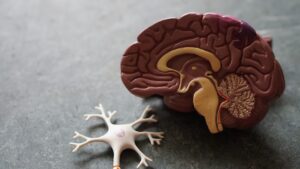EMDR therapy (Eye Movement Desensitization and Reprocessing) is a structured therapeutic technique developed in the late 1980s by American psychologist and educator, Francine Shapiro, Ph.D. It has since become a gold standard, evidence-based modality for treating the symptoms and emotional distress caused by post-traumatic stress disorder or other disturbing life events.
EMDR therapy focuses directly on your traumatic memory and on changing the way it is stored in your brain. It does not require that you talk about it in any detail, but rather, involves a guided process of bilateral stimulation such as moving your eyes a certain way or listening to a shifting tone, while simultaneously thinking of the image and feelings it evokes. McKinney Christian Counseling offers EMDR therapy as a faith-based approach to healing, helping individuals process past wounds and find lasting peace.
As the process is repeated, the vividness of the memory is reduced, as is the intensity of the emotions associated with it. Studies have shown that eye movement desensitization and reprocessing work faster than many other forms of therapy. It brings about rapid, effective change while enabling you to remain stable between sessions.
The Science Behind Eye Movement Desensitization and Reprocessing
 Your mind and your brain are two distinct entities. Your mind contains your thoughts, memories, beliefs, and experiences. How it interprets them, however, depends on whether your brain’s networks of communicating cells are operating the way they were created to.
Your mind and your brain are two distinct entities. Your mind contains your thoughts, memories, beliefs, and experiences. How it interprets them, however, depends on whether your brain’s networks of communicating cells are operating the way they were created to.
Your brain stores memories of traumatic events differently than normal ones. Memories of normal events are stored in a part of the brain that connects them to other memories. Memories of traumatic events, however, are not properly processed or stored. Circuits become blocked or unbalanced, preventing your brain from receiving the message that the danger is over, and the event is in the past.
Unprocessed memories feel as though the event is still happening in the present, and your mind remains sensitive to the thoughts, emotions, and physical sensations you felt at the time of the trauma. This is why certain sights, sounds, and smells, for instance, can continue to trigger strong emotions and make it feel as though you are reliving the traumatic event over and over again, and reinforce the memory of it.
This disconnect between the pathways controlling the areas of your brain where your memories, thoughts, and senses are located prevents healthy healing.
Eye movement desensitizing and reprocessing focuses on unblocking the pathways and changing the way your unprocessed memories are stored so that the distressing symptoms associated with them can be reduced and eliminated.
Using bilateral stimulation such as guided eye movements or a tone that beeps in one ear and then the other, activates both sides of your brain, enabling you to safely access traumatic memories, form new associations, and help repair the mental injury they caused, by reprocessing them in a different way so they can be properly stored.
Conditions That Can Be Treated By EMDR
Eye movement desensitization and reprocessing therapy is most commonly used to treat post-traumatic stress disorder (PTSD). However, it can also help with a wide range of other mental health conditions as well, such as anxiety disorders, addictions, obsessive-compulsive disorder, personality disorders, bipolar disorder, sexual dysfunction, phobias, and eating disorders.
Phases of EMDR Therapy
Eye movement desensitization and reprocessing therapy is an eight-phase treatment that takes place over the course of several sessions. Each session, once the active therapy begins, will include most of the phases except for the first two.
 Phase 1: History
Phase 1: History
Phase 1 is devoted to an intake history. The therapist will ask questions to gather information about you and your past, what current situations intensify your symptoms, and what motivated you to seek therapy. He or she will also assess your readiness, help you identify targets you want to focus on, and develop a treatment plan.
Phase 2: Preparation
In phase 2, the therapist will explain each step of the EMDR process, its purpose, and give you a chance to practice it. He or she will also equip you with calming, stress reduction techniques you can use to help manage any upsetting emotions that may come up.
Phase 3: Assessment
During phase 3, the therapist will help you identify a specific memory you want to work on during the reprocessing and have you express any negative images, feelings, physical sensations, or negative beliefs about yourself that are associated with it. In addition, he or she will have you choose a more realistic, positive belief about yourself that you would like to replace the negative one with going forward.
Phase 4: Desensitization
Phase 4 is where the reprocessing takes place. During this phase, the therapist will activate your target memory and have you hold it in your mind while you simultaneously pay attention to the back-and-forth movement of a moving light, his or her fingers, or a tone that alternately beeps in one ear and then the other.
The sets last about 30 seconds, and at the end of each one, you will be asked to identify any new thoughts or insights you may have spontaneously had about what you were experiencing. The process is then repeated until your level of distress goes down.
Phase 5: Installation
During phase 5 the emphasis shifts to the positive feeling, thought, or belief you identified in phase 3 as what you wanted to attach to the traumatic memory instead of the distressing ones it was previously tied to. Your therapist will use bilateral stimulation while having you focus on this positive affirmation and repeat the process until you are able to accept it and internalize it as being true.
Phase 6: Body scan
 Phase 6 helps identify your progress. During this phase, your therapist will have you focus on any symptoms you feel in your body as you think about the traumatic memory you have been working on. As you go through the phases, distressing symptoms should decrease as close to none as possible. Once you reach this point, the reprocessing of that memory is complete.
Phase 6 helps identify your progress. During this phase, your therapist will have you focus on any symptoms you feel in your body as you think about the traumatic memory you have been working on. As you go through the phases, distressing symptoms should decrease as close to none as possible. Once you reach this point, the reprocessing of that memory is complete.
Phase 7: Closure
Each session ends with phase 7 to make sure you leave feeling better than you did when you arrived for your appointment. If the targeted memory was not fully reprocessed, the therapist will tell you what to expect between sessions, and remind you to use the calming, stabilizing techniques you learned in phase 2 should you have any negative thoughts or feelings.
He or she may also ask you to write down any new thoughts or insights you have about the traumatic event during this time between sessions and bring it with you to your next one.
Phase 8: Reevaluation
Once the active part of therapy has begun, each new session starts with a reevaluation of your progress to make sure you are on track and to help determine if you need additional sessions or adjustments to your goals and expectations.
Benefits of Eye Movement Desensitization and Reprocessing
 Unlike other forms of trauma-related treatments, eye movement desensitization and reprocessing does not involve extended exposure to distressing memories, detailed discussion of traumatic events, or require you to relive them. Rather, it focuses directly on the targeted memory and on changing the way it is stored in the brain so you can realize that the event happened in the past and is no longer happening now.
Unlike other forms of trauma-related treatments, eye movement desensitization and reprocessing does not involve extended exposure to distressing memories, detailed discussion of traumatic events, or require you to relive them. Rather, it focuses directly on the targeted memory and on changing the way it is stored in the brain so you can realize that the event happened in the past and is no longer happening now.
If you have questions about this article on eye movement desensitization and reprocessing or would like to set up an appointment to meet with one of the faith-based counselors at Mckinney Christian Counseling, please don’t hesitate to give us a call.
References:
Cleveland Clinic Staff. “EMDR Therapy.” Cleveland Clinic. Reviewed on March 29, 2022. myclevelandclinic.org/health/treatments/22641-emdr-therapy.
“What Is EMDR?” EMDR Institute. emdr.com/what-is-emdr/.
“Trauma”, Courtesy of Susan Wilkinson, Unsplash.com, CC0 License; “Thanks”, Courtesy of Mor Shani, Unsplash.com, CC0 License; “Brain Model”, Courtesy of Robina Weermeijer, Unsplash.com, CC0 License; “Man at Sunset”, Courtesy of Silviu Zidaru, Unsplash.com, CC0 License
-
Caitlin Bailey: Author
As a counselor, my heart is to help individuals work through challenging circumstances and see those difficulties in light of God’s heart for them. I believe that healing comes through Christ alone and that the Lord draws near to those who are broken...
-
Kate Motaung: Curator
Kate Motaung is the Senior Writer, Editor, and Content Manager for a multi-state company. She is the author of several books including Letters to Grief, 101 Prayers for Comfort in Difficult Times, and A Place to Land: A Story of Longing and Belonging...
DISCLAIMER: THIS ARTICLE DOES NOT PROVIDE MEDICAL ADVICE
Articles are intended for informational purposes only and do not constitute medical advice; the content is not intended to be a substitute for professional medical advice, diagnosis, or treatment. All opinions expressed by authors and quoted sources are their own and do not necessarily reflect the opinions of the editors, publishers or editorial boards of Stone Oak Christian Counseling. This website does not recommend or endorse any specific tests, physicians, products, procedures, opinions, or other information that may be mentioned on the Site. Reliance on any information provided by this website is solely at your own risk.






